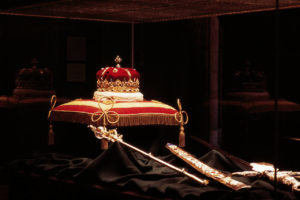From Montezuma’s gold to the crown jewels of Scotland, some of the world’s most famous valuables have gone missing.
January 23, 2020
What sort of nitwit goes off in a snowstorm to feed leftovers to the chickens while still wearing her Christmas Day finery? In my defense, I was just trying to share the love. Alas, I ended up sharing an antique ring along with the Brussels sprouts. Only the chickens know where it is, and they aren’t talking.

The Honours of Scotland were recovered in 1818 after being lost for decades. PHOTO: ALAMY
One doesn’t need to read J.R.R. Tolkien’s “The Lord of the Rings” to be reminded that lost treasures are often the result of epic folly. In October 1216, King John of England lost the crown jewels while leading a campaign against rebellious barons. Against all advice, John—who is chiefly remembered for being forced to sign the Magna Carta, one of the cornerstones of civil liberty—took a shortcut via the Wash, a tidal estuary on England’s east coast. He got across the causeway just in time to see the waters come rushing up behind him. The wagon train with all his supplies and baggage—including, crucially, the king’s treasury—sank without a trace. The incident has given countless British schoolchildren the joy of being able to say, “Bad King John lost his crown in the wash.”
Folly also played a starring role in the disappearance of the treasure of the Aztec Emperor Montezuma II. In 1520, the inhabitants of the Aztec city of Tenochtitlan rose up against the occupying Spanish forces led by Hernán Cortés. By July 1, the situation was so critical that the outnumbered conquistadors attempted a midnight escape from the city. Hampered by their haul of plunder, however, the Spanish were too slow in crossing Lake Texcoco. Unable to run or fight, desperation overcame their greed and the conquistadors tossed the treasures into the water. Despite losing half his men on what he called “La Noche Triste,” the Night of Sorrows, Cortes captured the Aztec capital a year later. But he never found the lost gold.
It was a case of absent-mindedness that led to the disappearance of the Scottish royal sword, scepter and crown, known collectively as the Honours of Scotland. Having been successfully hidden during the Interregnum, England’s brief experiment with republicanism in 1649-60, the Honours were returned to Edinburgh Castle for safekeeping. Too safe, it turned out: No one could remember where they were. But the story has a happy ending. In 1818, the Scottish novelist Sir Walter Scott received permission to conduct his own search of the castle. He found the Honours in a locked storeroom, inside a trunk packed with linens.
Occasionally, royal treasures have been lost on purpose. One of the last rulers to be buried with his jewels was Emperor Tu Duc of Vietnam (1829-83). To outwit potential grave robbers, he left orders that he should not be buried in his elaborate official tomb but in a secret location; to ensure it stayed secret, the laborers who interred him were executed. In 1913, Georges Mahé, the French colonial administrator of the Vietnamese city of Hue, provoked a national outcry after he dug up Tu Duc’s official tomb in the hope of finding the hidden jewels. The French swiftly apologized and Mahé was sacked.
Tu Duc’s treasure remains lost, but it may not stay that way forever. Earlier this month, scientists in Mexico City confirmed that a gold bar found on a construction site is one of the ingots discarded by Cortés and his fleeing conquistadors almost exactly 500 years ago.





